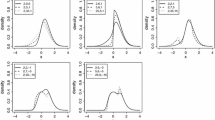Abstract
The skew-symmetric distribution is often-used as a skew distribution, but it is not always unimodal even when the underlying distribution is unimodal. Recently, another type of skew distribution was proposed using the transformation of scale (ToS). It is always unimodal and shows the monotonicity of skewness. In this paper, a multivariate skew distribution is considered using the ToS. The skewness for the multivariate skew distribution is proposed and the monotonicity of skewness is shown. The proposed multivariate skew dist ribution is more flexible than the conventional multivariate skew-symmetric distributions. This is illustrated in numerical examples. Additional properties are also presented, including random number generation, half distribution, parameter orthogonality, non-degenerated Fisher information, entropy maximization distribution.




Similar content being viewed by others
References
Arellano-Valle, R. B., & Azzalini, A. (2008). The centred parametrization for the multivariate skew-normal distribution. Journal of Multivariate Analysis, 99, 1362–1382.
Azzalini, A. (1985). A class of distributions which includes the normal ones. Scandinavian Journal of Statistics, 12, 171–178.
Azzalini, A. (2005). The skew-normal distribution and related multivariate families. Scandinavian Journal of Statistics, 32, 159–200.
Azzalini, A., & Capitanio, A. (1999). Statistical applications of the multivariate skew normal distribution. Journal of the Royal Statistical Society: Series B (Statistical Methodology), 61, 579–602.
Azzalini, A., & Capitanio, A. (2003). Distributions generated by perturbation of symmetry with emphasis on a multivariate skew \(t\)-distribution. Journal of the Royal Statistical Society: Series B (Statistical Methodology), 65, 367–389.
Azzalini, A., & Dalla Valle, A. (1996). The multivariate skew-normal distribution. Biometrika, 83, 715–726.
Cook, R. D., & Weisberg, S. (1994). An introduction to regression graphics. New York: Wiley.
Critchley, F., & Jones, M. C. (2008). Asymmetry and gradient asymmetry functions: density-based skewness and kurtosis. Scandinavian Journal of Statistics, 35, 415–437.
Fujisawa, H., & Abe, T. (2015). A family of skew distributions with mode-invariance through transformation of scale. Statistical Methodology, 25, 89–98.
Genton, M. G. (Ed.). (2004). Skew-elliptical distributions and their applications. Boca Raton, FL: Chapman & Hall.
Hallin, M., & Ley, C. (2012). Skew-symmetric distributions and fisher information-a tale of two densities. Bernoulli, 18, 747–763.
Jones, M. C. (2014). Generating distributions by transformation of scale. Statistica Sinica, 24, 749–771.
Jones, M. C. (2016). On bivariate transformation of scale distributions. Communications in Statistics-Theory and Methods, 45, 577–588.
Jones, M. C., & Pewsey, A. (2009). Sinh-arcsinh distributions. Biometrika, 96, 761–780.
Ley, C., & Paindaveine, D. (2010). On the singularity of multivariate skew-symmetric models. Journal of Multivariate Analysis, 101, 1434–1444.
Ma, Y., & Genton, M. G. (2004). Flexible class of skew-symmetric distributions. Scandinavian Journal of Statistics, 31, 459–468.
Pewsey, A. (2000). Problems of inference for azzalini’s skewnormal distribution. Journal of Applied Statistics, 27, 859–870.
Wang, J., Boyer, J., & Genton, M. G. (2004). A skew-symmetric representation of multivariate distributions. Statistica Sinica, 14, 1259–1270.
Acknowledgements
Toshihiro Abe was supported in part by JSPS KAKENHI Grant Number 19K11869 and Nanzan University Pache Research Susidy I-A-2 for the 2019 academic year. Hironori Fujisawa was supported in part by JSPS KAKENHI Grant Number 17K00065.
Author information
Authors and Affiliations
Corresponding author
Additional information
Publisher's Note
Springer Nature remains neutral with regard to jurisdictional claims in published maps and institutional affiliations.
Derivation of \(\partial \xi /\partial \lambda _j\) and \(\partial \xi /\partial a\)
Derivation of \(\partial \xi /\partial \lambda _j\) and \(\partial \xi /\partial a\)
The differential of a with respect to \(\lambda _j\) is given by
The numerator of \(\partial a/\partial \lambda _j\) is
Let \(\varvec{r}(\varvec{x};{\varvec{\lambda }})=\varvec{y}({\varvec{\lambda }})\). We have
The differential of the above with respect to \(\lambda _j\) is
Thus,
Therefore, the numerator of \(\partial a_+/\partial \lambda _j\) is given by
The denominator of \(\partial a/\partial \lambda _j\) is
Let \(\varvec{r}(\varvec{x};{\varvec{\lambda }})=\varvec{y}(\varvec{x})\). We have
The differential of the above with respect to \(\varvec{x}\) is
Thus,
Therefore, the denominator of \(\partial a_+/\partial \lambda _j\) is given by
Rights and permissions
About this article
Cite this article
Abe, T., Fujisawa, H. Multivariate skew distributions with mode-invariance through the transformation of scale. Jpn J Stat Data Sci 2, 529–544 (2019). https://doi.org/10.1007/s42081-019-00047-x
Received:
Accepted:
Published:
Issue Date:
DOI: https://doi.org/10.1007/s42081-019-00047-x




